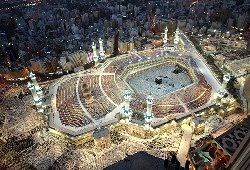Pilgrimage was ordained in the sixth year after the migration of the Prophet

. It suffices for a pilgrim to do it once in a lifetime, and performing it more than once is voluntary.
A Pilgrim whose Hajj is accepted by Allaah is given the good tidings that he would return with all his sins being forgiven. The Prophet

says:
“He who performs Hajj with no obscenity or evil practices will come out from all sins as a newly born baby.” [Al-Bukhaari and Muslim].
In this article, we will guide you through the steps of pilgrimage and try to be as brief as possible without leaving anything important out or un attended.
The Meeqaat: Upon arriving at the Meeqaat (the place from where a pilgrim assumes the state of Ihraam), perform Ghusl (a ritual bathe), perfume yourself, but not your pilgrimage garments, and put the two-piece garment on with no headgear. The garments should not be form-fitting. One piece to cover the upper part of the body, and the second to cover the lower part. The woman's Ihraam (i.e. garment of pilgrimage) is any decent, loose garment that covers her entire body and that fulfills all Islaamic conditions of Hijaab, while exposing her face, hands and not using any perfumes. If the time comes for obligatory prayer whilst assuming Ihraam, you should perform it. If not, you can pray two voluntary Rak'ahs after ablution.
You should initiate the state of Ihraam by proclaiming the type of Hajj you intend to perform. For Hajj Al-Ifraad you should say: "Labbayka Allaahumma Hajjan". For Hajj Al-Qiraan you should say: "Labbayka 'Umratan wa Hajjan". For Hajj At-Tamattu' you should say: "Labbayka 'Umrah". After concluding his 'Umrah, one goes back to normal (no Ihraam restrictions). Then, you repeat the supplication of Hajj, called Talbiyyah, saying: "Labbayka Allaahumma labbayk. Labbayka laa shareeka laka labbayk. Innalhamda wna-n'imata laka walmulk, laa shareek lak".
When you are in a state of Ihraam, you are not allowed to do any of the following: wear any form-fitting clothes, cut or shave hair from any part of the body, use perfumes on the body or clothes, clip your nails, engage in hunting, eat game meat (unless it was not exclusively hunted for him or another pilgrim), contract a marriage or have sexual intercourse and all matters leading to it. As for a woman pilgrim, she is forbidden to wear a Niqaab (i.e. a veil that is tied on the face), or gloves. However, in the presence of men she draws down a veil from her head to cover her face.
Arriving in Makkah: Upon arriving at the sacred mosque in Makkah (Al-Masjid Al-Haraam), you should enter with your right foot and say: "Bismillaah, Allaahumma Salli 'Alaa Muhammad, Allaahumma Ighfirli waftahli Abwaaba Rahmatik. (In the name of Allaah! O Allaah! Exalt the mention of your Messenger. O Allaah! Forgive my sins, and open the gates of your mercy for me)." You should enter in a manner expressing humility and gratitude to the blessings He conferred upon you.
Before performing Tawaaf (i.e. circumambulation), make sure that the sheets of Ihraam are in Idh-Dhibaa' position (to wrap the upper sheet of Ihraam below the right arm and hang over the left shoulder so that the right shoulder is uncovered), this is done exclusively during Tawaaf.
Start Tawaaf from the Black stone keeping the Ka'bah to your left. Kiss the Black Stone if possible, touch it with your right hand if possible, otherwise just point at it with your right hand, without harming others, saying: "Bismillaah, Allaah-u-Akbar". Then immerse your self in remembrance of Allaah, supplication and asking for forgiveness.
Hasten during the first three rounds of Tawaaf and walk during the remaining four. This fast walking is called Ramal.
Touch the Yamani Corner with your right hand whenever you pass by it if possible, without kissing it; if touching it is not possible, do not point at it. While you are passing between the two corners, it is recommended to say: "Rabbanaa Aatinaa Fid-Dunyaa Hasanatan Wa fil-Aakhirati Hasanatan Wa Qinaa 'Athaabannaar".
Circumambulate the Ka'bah for seven times starting from the Black Stone and ending by it; saying Allaah-u-Akbar whenever you are parallel to it. After Tawaaf, cover your right shoulder again, go to Maqaam Ibraaheem (Ibraaheem's station) and recite:
"Wattakhithoo Min Maqaami Ibraaheema Musallaa" [Al-Baqarah: 125] you should recite this in Arabic if you know how, otherwise just perform two Rak'ahs behind it (if possible or anywhere in the mosque when crowded). Recite chapter 109 of the Quran in the first Rak'ah and chapter 112 in the second.
Ascend Mount As-Safaa and recite (in Arabic only): "Inna As-Safaa Wal-Marwata Min Sha'aa'irillaah" [Al-Baqarah: 157]. After this you say: "I begin with what Allaah began with." Face the Ka'bah and raise your hands in supplication saying thrice: "Laa Ilaaha Illallaah wahdah, Anjaza Wa'dah, Wa Nasar 'Abdah, Wa Hazamal-Ahzaab Wahdah." Then supplicate for your self.
Descend from As-Safaa and head to Al-Marwah, when you reach the two green signs, increase your pace between them and run. Then return to your normal pace until you reach Al-Marwah. Immerse your self in remembrance of Allaah praying to him whilst walking.
Upon reaching Al-Marwah, ascend it, face the Ka'bah and say as you've said on As-Safaa. Thus you have fulfilled one lap of seven. Going back to As-Safaa, walk calmly and hasten on reaching the aforementioned green sign. The same steps are repeated in each of the seven laps.
Shaving the Head or Trimming the Hair: After Sa'y, (i.e. walking between As-Safaa and Al-Marwah seven times) if you are performing Hajj At-Tamatt'u it is preferable to trim (and not shave) your hair and with this you end your 'Umrah rites. At this stage, the prohibitions of the state of Ihraam are lifted and you can resume your normal life. If you are performing Hajj al-Qiraan or al-Ifraad, you remain in the state of Ihraam and this Sa'y suffices you from having to do it at the end of Hajj.
The Tarwiyyah Day: On the 8
th of Thul-Hijjah, a Pilgrim performing Hajj At-Tamatt'u should assume Ihraam again from where he is staying, saying: "Labbayka Allaahumma Hajjan".
It is better to leave for Minaa in the morning. In Minaa, the pilgrims pray Thuhr, 'Asr, Maghrib and 'Ishaa' of the 8
th and Fajr of the 9
th ('Arafah day). Thuhr, 'Asr and 'Ishaa' are shortened to two Rak'ahs, but are not combined. One should increase remembrance of Allaah and supplication, and repeat Talbiyyah.
Departure to 'Arafaat: On the 9
th of Thul-Hijjah. ('Arafaah day), you stay in 'Arafaat until sunset. It is preferable to pray Thuhr and 'Asr at 'Arafaat, shortened and combined during the time of Thuhr. Make sure that you stay within the boundaries of 'Arafaat, not necessarily standing on the mountain of 'Arafaat. You should spend most of the day glorifying Allaah, supplicating and asking forgiveness, raising your hands in supplication as did the Prophet

.
Leaving for Muzdalifa: After sunset, on 'Arafah day, quietly and reverently leave for Muzdalifah in compliance with the advice of the Prophet

. In Muzdalifah, the pilgrim combines Maghrib and 'Ishaa' prayers, shortening the 'Ishaa' prayer to two Rak'ahs. Spend the night in Muzdalifah to perform the Fajr prayer of the next day. Then you should immerse yourself in remembrance of Allaah praying to Him.
Stoning Jamartul-'Aqabah: Before sunrise, head to Minaa to throw the pebbles. Walk calmly, repeating Talbiyyah throughout the way. When you reach Jamratul-'Aqabah, stop saying Talbiyyah and stone the seven pebbles saying: "Allaah-u-Akbar" at each throw.
The end of the First Phase of the State of Ihraam: After stoning Jamratul-'Aqabah, the pilgrim goes to slaughter his sacrifice himself or he appoints somebody else to do it. He eats of it and feeds the poor. The final rite on the tenth day is to shave your head or shorten it. Shaving the head is more rewarding. For women, the length of hair to be cut is that of a fingertip. Stoning Jamraul-'Aqabah, and shaving the head or trimming the hair symbolize the end of the first phase of the state of Ihraam and the lifting of its restrictions, except for sexual intercourse with one's spouse.
Tawaaf Al-Ifaadhah: After performing all the aforementioned steps, go to Makkah to perform Tawaaf Al-Ifaadhah by circling the Ka'bah seven times and praying two Rak'ahs behind Maqaam Ibraaheem, without causing any harm to Muslims, otherwise any where in the Haram. Then perform Sa'y between As-Safaa and Al-Marwah if you are performing Hajj At-Tamatt'u, or if you are performing Hajj al-Qiraan, or al-Ifraad and did not perform it with your first Tawaaf. After Tawaaf Al-Ifaadhah the state of Ihraam ends and all restrictions are lifted, including sexual intercourse with one's spouse. Tawaaf Al-Ifaadhah can be delayed until the days spent in Minaa are over.
Spending the Night at Minaa: After Tawaaf Al-Ifaadhah you should return to Minaa and spend the days of Tashreeq there (11
th, 12
th and 13
th of Thul-Hijjah). The first two nights are an obligatory rite of Hajj and must be fulfilled and the third one is optional.
Stoning: During each of the days of Tashreeq, stone the three stone pillars called "Jamaraat" (small, medium and Jamratul-'Aqabah) saying: "Allaah-u-Akbar" with each throw of the seven pebbles, stoned successively at each pillar. The time of stoning the three Jamaraat is after zenith. It is commendable, after stoning the first Jamarah and the second Jamarah, to face the direction of the Qiblah and supplicate to Allaah. After Stoning the largest Jamarah (Jamaratul-'Aqabah), do not stop for supplication.
Farwell Tawaaf: The farewell Tawaaf is the final rite of Hajj. When you intend to go home, go to Makkah and perform the Farewell Tawaaf around the Ka'bah. However, women in their menstrual or postnatal period are exempted from this Tawaaf.
http://www.islamweb.net/ver2/archive/article.php?lang=E&id=135517








 Please check our
Please check our 







